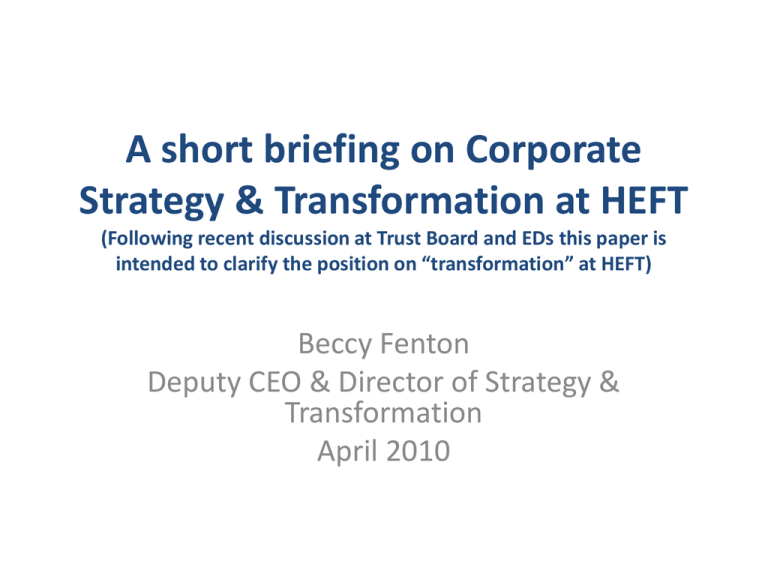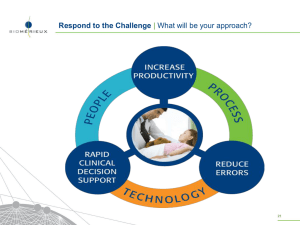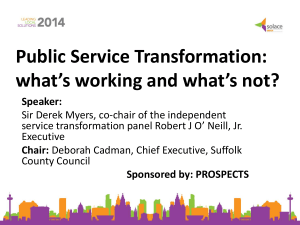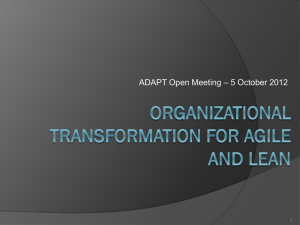original attachment
advertisement

A short briefing on Corporate Strategy & Transformation at HEFT (Following recent discussion at Trust Board and EDs this paper is intended to clarify the position on “transformation” at HEFT) Beccy Fenton Deputy CEO & Director of Strategy & Transformation April 2010 Strategy Alignment Corporate Strategy Transformation Strategy Enabling Strategies Annual Corporate Business Plan Corporate Strategy Sets out the vision and blue print for the organisation by 2015. The DH have recently published the NHS Strategy and Vision for 2015 in “Good to Great”. This describes a) the standard of care that the public will experience, b) the workplace and benefits to staff and c) what the system will look like to support the vision (e.g. integrated care). This is a good example of the sort of document we need to produce for HEFT. Transformation Strategy This sets out the road map and journey that the organisation needs to take over a 5 year period to transform from its current state to achieve its future vision. Currently HEFT has adopted the “Transformation Diamond Diagram” as its framework for transformation stating that it will need to focus its transformation on; culture, access and flow, safety, collaboration, environment and clinical outcomes. In the absence of a Corporate Strategy/Blue print for 2015 HEFT’s Transformation Strategy can only look forward about a year in terms of setting out specific improvement activities. Once the new Corporate Strategy has been produced then the Transformation road map can be updated to extend across the same time frame. Enabling Strategies HEFT’s enabling strategies such as Service Strategies, Site Strategy, OD, ICT, Financial etc will need to be reviewed to ensure they support the new Corporate Strategy and Transformation Road Map for the same time period. Annual Corporate Business Plan Each year the Trust will set out specific activities that will be the focus for the coming 12 months with detailed project plans and measurable outcomes to ensure progress is made in the short term to deliver the longer term plans. A History of the Trust’s investment and support for the delivery of continuous improvement and the Transformation Strategy In 2007/08 the Trust agreed to invest in a small Transformation Team to support the Organisation in its delivery of the Transformation Strategy to improve quality and productivity. The Team was similar to previous NHS improvement teams often referred to as “Service Improvement” or “Modernisation” Teams. The HEFT team consisted of the following posts: •Service Transformation Support – Cheryl Hudson •Business Transformation Support – Kate Barber (replaced 0.5 wte by Paul Chew in 2008) •Service Improvement Manager Medicine Business Unit – Helen Slater •Service Improvement Manager Surgery Business Unit – Jo Hodgkiss The team worked on a variety of projects during this early stage including OP Booking, Emergency Flow, SLRs, relocation of back office functions. During this period the Trust recognised that the “burning platform” for change was not “hot enough” due to a stable world wide economic position, high levels of NHS funding growth and 5 year financial forecasts at HEFT which would enable a £290 million pound estate investment strategy and good performance against the external rating system. Against this back drop transformation was slow and it was difficult to engage operations in continuous improvement activities. During 2008 many parts of NHS began to get interested in how the application of Lean in healthcare could enable the seemingly impossible task of improving the quality of patient care, staff morale and value for money. Under the remit of the then Medical Director for Surgery, a Head of Lean was appointed to grow an internal resource for training staff and applying Lean techniques to our continuous improvement agenda. Lean was introduced to the Trust as a series of small local improvement projects which quickly demonstrated that significant improvements could be made in reducing LOS, waiting times and mortality by applying techniques such as process mapping and rapid improvement events to redesign systems and processes that put the patient at the centre. The success of these local projects all relied on engagement and buy in from front line staff and therefore also succeed in improving front line engagement and morale. It is fair to say that fairly quickly the Lean team’s credentials and expertise over took the transformation team’s traditional NHS improvement skills and there became some confusion over the roles and differences. So it was agreed that as part of the organisational re-structure plans, the role of transformation/service improvement would be integrated into the new groups structures and the Transformation team was disbanded on 1st April 2009. The Lean Team continues to support continuous improvement through training and facilitation of improvement events as per its 2009/10 Business Plan approved by the EDs earlier in the year. Many other organisations have spent several hundreds of thousands of pounds and in some cases millions by buying in external Lean expertise. We continue to grow our own internal capacity to ensure sustainability and learning within HEFT. The 2010/11 Lean Business Plan will be presented to EDs Committee in May. Department of Strategy & Transformation Budget – Head of Department, Beccy Fenton Budgets 2010/11 Strategy Development & Support (old Transformation Team Budget) £ Non Pay Usual non pay items 36,000 Pay 1.0 WTE Beccy Fenton’s PA (Angela Hudson) 0.5 wte Paul Chew (Business transformation support, replaced Kate Barber half time) Plus remaining vacant budget left over from old “Transformation Team” which ceased to exist on 1st April 2009, less CIPs. 144,329 Old team included Cheryl Hudson (now GHH), Jo Hodgkiss (now full time HEFT Cons, Helen Slater (left) and Kate Barber (left). In 2009/10 some of this vacant budget had been used to cover the internal costs of support to the Trust on projects such as ADTs, 4 hour access programme set up, T&O Review, Business Planning Support, Directorate Best Practice Reviews. The external cost of this support would have been far greater. TOTAL Lean Team 180,329 Non pay Usual non pay items 36,877 Pay 1.0 WTE Head of Lean 3.0 WTE Site Lean Academy Leads 3.0 WTE Analysts 0.75 WTE PA 0.4 WTE Clinical Lead 1.0 WTE Vacant (part of Productive theatre pilot) 632,366 TOTAL TOTAL BUDGET FOR DEPARTMENT OF STRATEGY & TRANSFORMATION 669,243 849,572 Next Steps • • Begin process for updating the Trust’s Corporate Strategy and blue print for 2015. Update Transformation Strategy to clearly set out the road map for transforming the Trust from its current state to its new blue print for 2015 setting out annual milestones for each element of the Diamond Diagram. • Update Enabling Strategies to ensure all align and support the delivery of the revised Corporate Strategy. • Deliver 2010/11 Corporate Business Plan and continue to produce robust annual corporate plans that are integrated across the whole organisation. • Ensure full integration of the transformation agenda as set out in the 2010/11 Corporate Business Plan into the Group Business Plans and performance management frameworks. • Produce Lean Business Plan 2010/11 for EDs Committee May. Decision • Following discussion at April’s Trust Board, the EDs are asked to consider whether an External Review is required of “transformation” and if so what the scope of this is and what value it will bring. Scope is currently unclear and could include the following: – Transformation Strategy Framework (Diamond Diagram ratified by EDs Away Day Dec 09)? – Progress and pace of the Trust in transforming culture, access and flow, safety, collaboration, environment, clinical outcomes to improve Patient Quality, Staff Morale and Productivity? – Methodologies used e.g. Lean, OD, SBAR? – Methodology and ability to effectively deliver complex trust wide programmes of change? – Assessment of our culture and whether it is one of “continuous improvement” with empowered and engagement front line staff? – Other?









